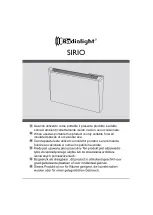
Section 9
–
Battery and Battery Charge
r
1 Flash
Battery Voltage High: Auto-recover. May be temporary
condition, or wrong charger installed, i.e. 36 volt charger on 48
volt battery pack.
2 Flash
Battery Voltage Low: Auto-recover. Confirm each individual
batteries minimum voltage with a volt meter. Two or more 6 volt
batteries register less than 5.85 volts, or accumulative total
pack voltage has been discharged to less than 20% remaining.
Vehicle operation will cease until batteries are recharged. See
Special Procedure for Excessively Discharged Batteries in this
section.
3 Flash
Charge Timeout: The charging did not complete in allowed time,
12-14 hours. This may indicate a battery problem, or that the
charger output was reduced due to high ambient temperatures.
Disconnect AC supply, confirm sufficient ventilation, allow cool
down time, and restart charger.
4 Flash
Check Battery: The batteries could not be trickle charged up to
a minimum level to start charger. This may be the result of badly
discharged batteries, or one (or more) damaged cells.
See Special Procedure in this section.
5 Flash
Over-Temperature: The charger shut down due to high internal
temperature. May require reset (AC unplugged) and a cool
down to restart charging cycle. This fault may indicate
inadequate cooling airflow or high ambient air temperatures.
Check for debris or blockage at cooling fi ns. Move the vehicle
to a cooler better ventilated area, or adjust time of day when
charging.
6 Flash
Delta-Q Charger Fault: An internal fault was detected and
charger may need to be checked/replaced by a qualified dealer
technician. It may also be the result of badly discharged
batteries, or one (or more) damaged cells. A RED 6 FAULT
flash must be validated first by testing individual batteries with
a voltmeter, and see Special Procedures, before deciding
charger has failed.
A Steady Red Fault LED
Confirms an internal electrical fault of the Delta-Q and also
requires charger replacement and return.
CHARGING PROCEDURE
1. Check electrolyte level in all cells. Add distilled water as
necessary to cover tops of plates. Do not over fill, as
electrolyte expands during charging.
2. Be sure charger is turned OFF. Insert electrical plug into
vehicle’s charger receptacle.
3. Charger will start automatically. Check that amp meter
rises fully when charger starts. If charger needle only rises
to half scale or does not rise at all, check AC outlet for
proper power supply or check charger owner’s manual for
testing and repair information.
TESTING BATTERIES
SPECIFIC GRAVITY TEST
NOTICE: Specific Gravity Test information does not apply
to sealed batteries.
It is possible to determine a battery’s ability to perform by
measuring the specific gravity of each cell with a hydrometer.
The hydrometer readings indicate two things:
▪
State of Charge - The amount of electrical power stored in
the battery.
▪
Condition - The ability of battery to store and deliver power.
NOTICE: Batteries should be fully charged before
performing specific gravity tests to determine battery
condition. Hydrometer tests of batteries not fully charged
are misleading and inconclusive.
HYDROMETER TEST
1. Squeeze rubber bulb and insert nozzle in cell, release bulb,
slowly drawing electrolyte up into barrel.
2. Adjust electrolyte level in barrel so float rides free of bottom
but is not striking top of barrel.
3. Hold hydrometer vertically, making sure float moves freely
and is not contacting sides of barrel. Read scale at the level
of electrolyte in the barrel. Record the reading.
4. Return electrolyte to cell from which it was removed.
5. Repeat these steps on all battery cells.
Hydrometer readings are affected by the temperature of the
electrolyte being tested. Measure the temperature of the
electrolyte, and correct the readings as follows:
Above 80ºF
: Add .004 to the specific gravity readings for each
10º above 80ºF (26ºC).
Below 80ºF
: Subtract .004 from the specific gravity readings for
each 10º below 80ºF (26ºC).
Results Interpretation
State of charge. Check specific gravity of each cell. See Table
2 & 3.
Specific Gravity vs, State of Charge
SG Reading at 80
o
F.
State of Charge
Содержание Expediter EX21-24A
Страница 1: ...Columbia ParCar Corp SERVICE MANUAL Expediter EX21 24S EX21 24A EX21 48A 2013...
Страница 8: ...Service Manual Section 2 General Information...
Страница 13: ...Section 2 General Information...
Страница 27: ...Section 4 Troubleshooting Figure 4 7...
Страница 35: ...Section 5 Accelerator Brake System Figure 5 1 Figure 5 2...
Страница 44: ...Section 6 Front wheels Fork Steering 6 Install steering column guard...
Страница 45: ...Section 6 Front wheels Fork Steering Figure 6 5...
Страница 46: ...Section 6 Front wheels Fork Steering 6 4...
Страница 50: ...Section 6 Front wheels Fork Steering Service Manual Section 7 Rear Wheels Rear Suspension Axle Assembly...
Страница 51: ...Section 6 Front wheels Fork Steering 2013 EX 21 Service Manual...
Страница 56: ...Section 7 Rear Wheels Rear Suspension Axle Assembly Figure 7 4...
Страница 57: ...Section 7 Rear Wheels Rear Suspension Axle Assembly Figure 7 6...
Страница 60: ...Section 7 Rear Wheels Rear Suspension Axle Assembly...
Страница 67: ...Section 7 Rear Wheels Rear Suspension Axle Assembly...
Страница 70: ......
Страница 72: ...Figure 8 6 8 2...
Страница 83: ...Section 9 Battery and Battery Charger...
Страница 84: ...Service Manual Section 10 Traction Drive System TRACTION MOTOR MAINTENANCE...
Страница 89: ...Section 10 Traction Drive System Figure 10 10...
Страница 90: ...Section 10 Traction Drive System...
















































